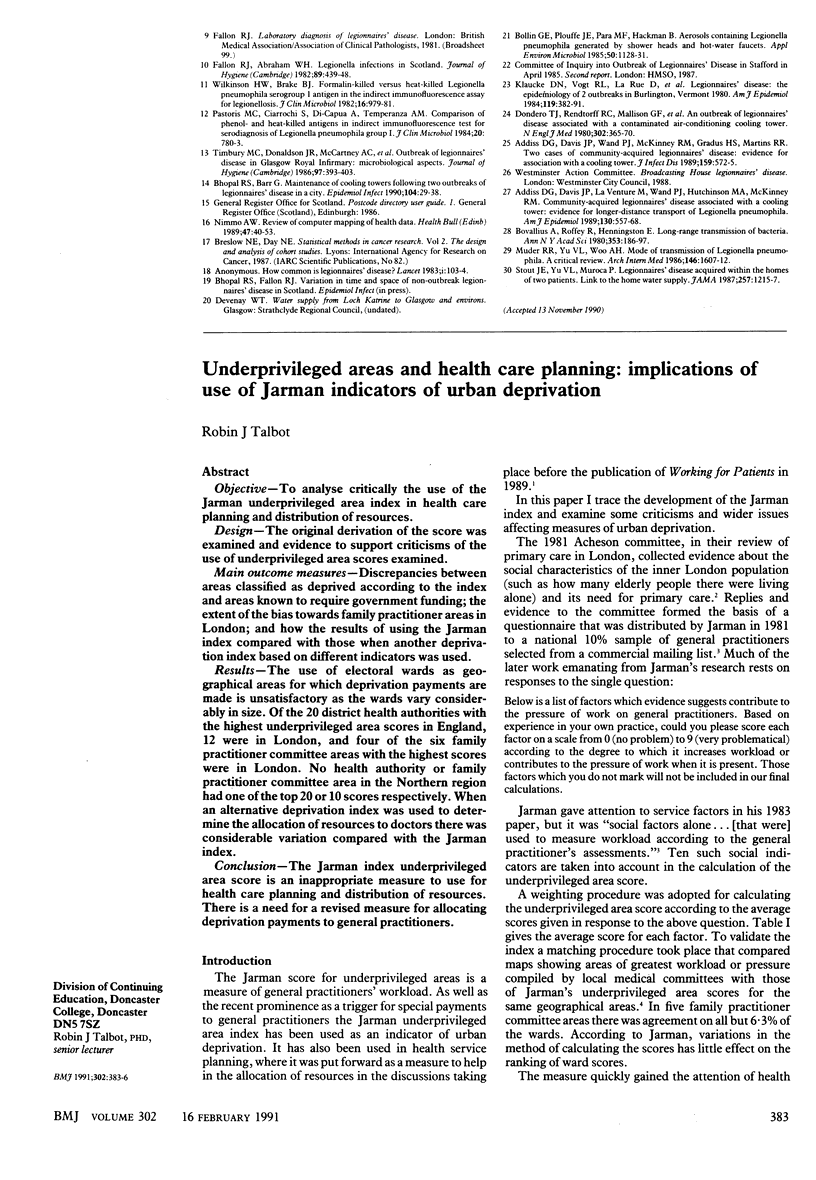Abstract
OBJECTIVE--To study the source of non-outbreak legionnaires' disease, particularly the role of cooling towers, by comparing the locations of patients' homes in relation to the location of cooling towers. DESIGN--Retrospective, descriptive study of a case series of patients with legionnaires' disease ill between 1978 and 1986 and, for comparison, a case series of patients with lung cancer. A prospectively developed register and interview based survey provided data on the location of cooling towers. SETTING--The city of Glasgow. PATIENTS--134 patients aged 14-84 with legionnaires' disease during 1978-86 and 10,159 patients with lung cancer during the same period. MAIN OUTCOME MEASURES--The locations of patients' homes and cooling towers as defined by postcodes, which provided map grid references accurate to 10 m; numbers of expected and observed cases of legionnaires' disease in census enumeration districts; and distance of enumeration districts from the nearest cooling tower as defined by five distance categories. RESULTS--Most cooling towers were in or near the city centre or close to the River Clyde, as were the places of residence of patients with community acquired, non-travel, non-outbreak legionnaires' disease (n = 107). There was an inverse association between the distance of residence from any cooling tower and the risk of infection, the population living within 0.5 km of any tower having a relative risk of infection over three times that of people living more than 1 km away. There was no such association with respect to travel related legionnaires' disease, and for lung cancer the association was weak (relative risk less than or equal to 1.2 in any distance group). CONCLUSION--In Glasgow cooling towers have been a source of infection in two outbreaks of legionnaires' disease and, apparently, a source of non-outbreak infection also. Better maintenance of cooling towers should help prevent non-outbreak cases. This method of inquiry should be applied elsewhere to study the source of this and other environmentally acquired disease.
Full text
PDF





Selected References
These references are in PubMed. This may not be the complete list of references from this article.
- Addiss D. G., Davis J. P., LaVenture M., Wand P. J., Hutchinson M. A., McKinney R. M. Community-acquired Legionnaires' disease associated with a cooling tower: evidence for longer-distance transport of Legionella pneumophila. Am J Epidemiol. 1989 Sep;130(3):557–568. doi: 10.1093/oxfordjournals.aje.a115370. [DOI] [PubMed] [Google Scholar]
- Addiss D. G., Davis J. P., Wand P. J., McKinney R. M., Gradus M. S., Martins R. R. Two cases of community-acquired Legionnaires' disease: evidence for association with a cooling tower. J Infect Dis. 1989 Mar;159(3):572–575. doi: 10.1093/infdis/159.3.572. [DOI] [PubMed] [Google Scholar]
- Bhopal R. S. A survey of laboratory services for the diagnosis of Legionnaires' disease in Scotland. Health Bull (Edinb) 1990 Nov;48(6):288–293. [PubMed] [Google Scholar]
- Bhopal R. S., Barr G. Maintenance of cooling towers following two outbreaks of Legionnaires' disease in a city. Epidemiol Infect. 1990 Feb;104(1):29–38. doi: 10.1017/s0950268800054492. [DOI] [PMC free article] [PubMed] [Google Scholar]
- Bovallius A., Roffey R., Henningson E. Long-range transmission of bacteria. Ann N Y Acad Sci. 1980;353:186–200. doi: 10.1111/j.1749-6632.1980.tb18922.x. [DOI] [PubMed] [Google Scholar]
- Chatterjee A. K., Ross L. M., McEvoy J. L., Thurn K. K. pULB113, an RP4::mini-Mu plasmid, mediates chromosomal mobilization and R-prime formation in Erwinia amylovora, Erwinia chrysanthemi, and subspecies of Erwinia carotovora. Appl Environ Microbiol. 1985 Jul;50(1):1–9. doi: 10.1128/aem.50.1.1-9.1985. [DOI] [PMC free article] [PubMed] [Google Scholar]
- Dondero T. J., Jr, Rendtorff R. C., Mallison G. F., Weeks R. M., Levy J. S., Wong E. W., Schaffner W. An outbreak of Legionnaires' disease associated with a contaminated air-conditioning cooling tower. N Engl J Med. 1980 Feb 14;302(7):365–370. doi: 10.1056/NEJM198002143020703. [DOI] [PubMed] [Google Scholar]
- Fallon R. J., Abraham W. H. Polyvalent heat-killed antigen for the diagnosis of infection with Legionella pneumophila. J Clin Pathol. 1982 Apr;35(4):434–438. doi: 10.1136/jcp.35.4.434. [DOI] [PMC free article] [PubMed] [Google Scholar]
- Fallon R. J. Legionella infections in Scotland. J Hyg (Lond) 1982 Dec;89(3):439–448. doi: 10.1017/s002217240007100x. [DOI] [PMC free article] [PubMed] [Google Scholar]
- Klaucke D. N., Vogt R. L., LaRue D., Witherell L. E., Orciari L. A., Spitalny K. C., Pelletier R., Cherry W. B., Novick L. F. Legionnaires' disease: the epidemiology of two outbreaks in Burlington, Vermont, 1980. Am J Epidemiol. 1984 Mar;119(3):382–391. doi: 10.1093/oxfordjournals.aje.a113756. [DOI] [PubMed] [Google Scholar]
- Muder R. R., Yu V. L., Woo A. H. Mode of transmission of Legionella pneumophila. A critical review. Arch Intern Med. 1986 Aug;146(8):1607–1612. [PubMed] [Google Scholar]
- Nimmo A. W. The Chief Scientist reports ... review of computer mapping of health data. Health Bull (Edinb) 1989 Jan;47(1):40–48. [PubMed] [Google Scholar]
- Pastoris M. C., Ciarrocchi S., Di Capua A., Temperanza A. M. Comparison of phenol- and heat-killed antigens in the indirect immunofluorescence test for serodiagnosis of Legionella pneumophila group 1 infections. J Clin Microbiol. 1984 Oct;20(4):780–783. doi: 10.1128/jcm.20.4.780-783.1984. [DOI] [PMC free article] [PubMed] [Google Scholar]
- Redd S. C., Cohen M. L. Legionella in water: what should be done? JAMA. 1987 Mar 6;257(9):1221–1222. [PubMed] [Google Scholar]
- Stout J. E., Yu V. L., Muraca P. Legionnaires' disease acquired within the homes of two patients. Link to the home water supply. JAMA. 1987 Mar 6;257(9):1215–1217. [PubMed] [Google Scholar]
- Timbury M. C., Donaldson J. R., McCartney A. C., Fallon R. J., Sleigh J. D., Lyon D., Orange G. V., Baird D. R., Winter J., Wilson T. S. Outbreak of Legionnaires' disease in Glasgow Royal Infirmary: microbiological aspects. J Hyg (Lond) 1986 Dec;97(3):393–403. doi: 10.1017/s0022172400063580. [DOI] [PMC free article] [PubMed] [Google Scholar]
- Wilkinson H. W., Brake B. J. Formalin-killed versus heat-killed Legionella pneumophila serogroup 1 antigen in the indirect immunofluorescence assay for legionellosis. J Clin Microbiol. 1982 Nov;16(5):979–981. doi: 10.1128/jcm.16.5.979-981.1982. [DOI] [PMC free article] [PubMed] [Google Scholar]


